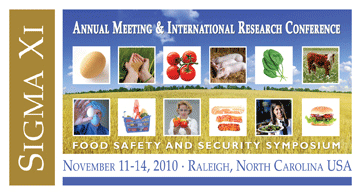Food Safety and Security
 "Food Safety and Security: Science and Policy" was the timely theme November 11-13 for a symposium during the 2010 Sigma Xi Annual Meeting and International Research Conference at the Raleigh Convention Center in downtown Raleigh, North Carolina.
"Food Safety and Security: Science and Policy" was the timely theme November 11-13 for a symposium during the 2010 Sigma Xi Annual Meeting and International Research Conference at the Raleigh Convention Center in downtown Raleigh, North Carolina.
The symposium provided a forum for experts and key players from academe, industry and government to begin a dialogue that ultimately informs, as well as raises awareness to, policymakers and the general public about the implications and critical importance of these issues. As the multidisciplinary honor society of research scientists and engineers, Sigma Xi is in a unique position to guide this discussion.
News headlines have raised public awareness of food safety issues, as Salmonella in salami and E. coli-tainted produce have sickened hundreds. A study published by the Produce Safety Project of The Pew Charitable Trusts at Georgetown University found that food-borne illnesses cost $152 billion a year in the U.S. alone. It's estimated that 76 million Americans annually are sickened by the food they eat.
Meanwhile, the federal government has pledged to step up efforts to enhance food safety. Technology was brought to bear earlier this year when frequent-shopper cards were used at grocery stores for the first time to trace the source of a Salmonella outbreak. Unfortunately, the public-health debate often neglects the science behind such outbreaks.
In an award-winning American Scientist article called "Safer Salads," from the November-December 2007 issue, the authors found that sanitation can break down during growth, harvest, washing, storage, transport or display of fruits and vegetables. They described new research into post-harvest treatments that could minimize consumer risk in the near future.
Food security has emerged as the unprecedented challenge of feeding the world's growing population. This complex topic stands at the intersection of many disciplines. Challenges include the physical, biological and socio-economic constraints that limit food production and the ability of people to obtain a healthy diet. Chronic food insecurity often means famine and hunger.